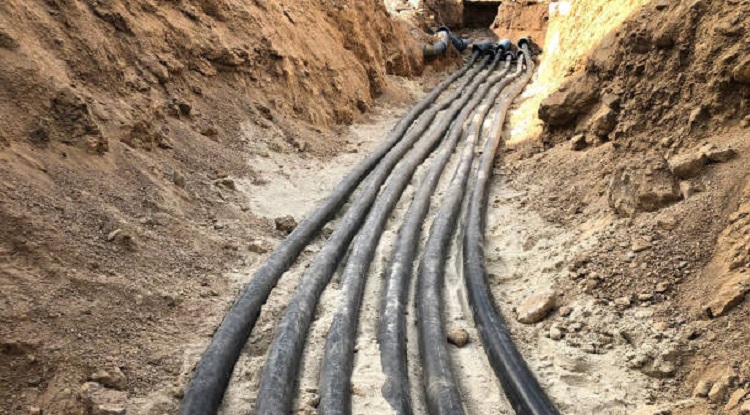This electrical safework method statement describes the management arrangements and system of work to adopted for the laying cable for the electrical project.
Below is necessary tools & equipment for performing the site activities for laying the cable.
- Cable Rollers
- Cable Pulling Grip
- Hand Cable cutter
- Manual Cable Crimpers
- Hydraulic Pole Saws
- Hand shovel
- Pickaxe
General Safety Precautions
One of the main aspects of this procedure is Safety and Health Control. This is to control occurrence of workers injuries as well as damage to equipment and properties during the entire construction period.
In order to ensure a safe working environment during the entire construction work, the safety measures will be implemented as follows:
Barricades/Signs will be provided sufficiently and maintained, as precautionary measures during the entire stage of construction, to protect the work, workmen and safety of the public.
In case of precaution against failure of lights, barricades will be equipped with suitable reflecting material.
Barricade will be made to indicate the construction boundary.
Prior to using any machines/equipment at site, they will be inspected and certified by qualified person.
Periodic Preventive Maintenance will be made on all equipment and machines.
Operators and drivers are to be equipped with valid driver’s/operator’s license or permit from concerned government agency.
Working in the night time and/or during rain will not be allowed.
Only authorized signalman will be assigned together with the operator or driver.
Personal Protective Equipment (PPE including mask gas filter type) will be issued to all workers such as safety shoes, hardhat, working gloves, safety goggles (if required).
Regularly check that safe working condition is obtained prior to start of cable laying works.
Construction waste will be disposed off in an appropriate manner.

There will be no dumping of garbage, waste, construction debris, motor oils, etc., on the site or on the adjoining vegetated areas.
The transportation path from site to the dumping area will always keep clean and free from soil, waste matter that may falling down during transportation.
Any potentially dusty material being transported from work sites will be securely contained.
Transporting vehicles, etc., will be monitored to prevent overloading and over-filling.
Additional Precautions include:
- Personnel to wear suitable PPE when cable pulling
- Cable jacks to be of sufficient capacity and placed on even surface
- Damaged cable drum not to be used.
- Competent personnel using suitable tools will carry out cable pulling and cable laying.
- Warning signs to be positioned adjacent to cable laying area.
- Personnel to be instructed / trained for the cable pulling techniques.
Cable Pulling Method
Where bends in conduits are encountered in a run, the cables shall be lubricated with a cable pulling lubricant, to facilitate drawing in, petroleum based products are not acceptable.
During installation operations, cables must not be bent to a radius of less than 12 times the overall diameter of the cable.
These conditions shall be strictly adhered to, particularly where cables turn into road crossings, conduit entry, etc.
Rollers must be used where cables are installed in an open trench using a pulling rope and eye; cable rollers are to be used at frequent intervals to support the cables and must never be more than 3 meters apart.
Care must be taken to ensure that the cable does not enter or leave the rollers at an angle that exceeds the bending radius of the cable.
The rollers are to be placed securely to prevent movement.
Before driving any spikes to secure the rollers, care must be taken to avoid other utilities’ equipment, which may exist below.
Pulling rope must be equipped with a swivel and be attached to the cable by a stocking grip with pulling eye.
Cable shall by manually drawn, before the pull commences, to stop the winch from moving with subsequent uneven pulling of the cable.
The cable shall be drawn into the trench smoothly with a minimum of stops and at an average speed of between 9-12 meters per minute, to avoid irregular movement.
Cable Laying Method
The drum should be mounted on jacks, cable trailer or cable stands such that the cable is preferably pulled from the top and always in the direction opposite to that indicated by the arrow.
Lighter cables may be laid by mounting the cable drum on its side on a truck-mounted turntable and laying the cable directly into the trench.
When pulling from large drums, i.e. over 2m in diameter, the cable should be supported to prevent stressing the cable, from the drum to the trench on a suitable ramp.
Alternatively, cables can be rolled directly into a trench from the drum mounted on an excavator moving along the trench.
To limit the chance of damage to the cable prior to removing the cable drum battens, a check should be done to ensure that the drum-spindle is level and permits even rotation of the drum.
During pulling there is a tendency for cable slack to accumulate on the drum, slack shall be avoided and one possible method to achieve this is to limit drum rotation by using plank brake shoes against one or both flanges of the drum.
If the inner end of the cable on the drum end protrudes through the side of the drum, then it should be watched during pulling to ensure it is not damaged.
It is advisable to tie a rope to the drum end, and pull through any slack cable that appears.
Pulling through drum end prevents buckling and possible damage to the inner coils on the drum.
Discover more from Project Management 123
Subscribe to get the latest posts sent to your email.